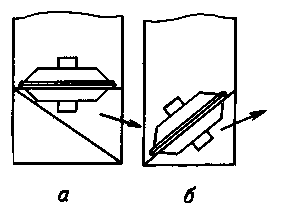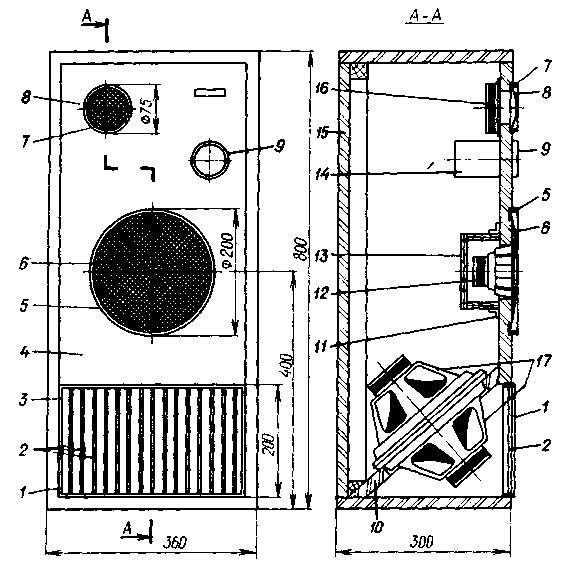Acoustic system (as) with dual heads [1] interested in a lot of radio Amateurs. Many of them opted on such AU and, judging by the reviews, happy with their sound. Interest in dual heads showed by some foreign firms. For example, in 1985 the company "Jamo" advertised a number of new AC, arguing in the prospectus of [2] that their large capacity and high fidelity with relatively small dimensions achieved through the use of dual heads. However, the lack of insight and, most importantly, practical advice on the design of the speaker with such heads, as well as the introduction of modern low-frequency compression emitter reduced interest in Amateur radio to dual dynamic heads. Recent studies have revealed new advantages of this type of emitters. By the way, it turned out that the optimal design is one in which the head is turned diffusers to one another, so in the future we will be talking only about this option.
The main advantages of a dual head (versus single) - smoother frequency response, lower harmonic distortion and lower the volume of the acoustic box design. Frequency response is smoothed through a mutual damping of heads, which is made up of dual [1]. Every single head in the permissible deviations, caused by the production technology, frequency response, so the frequency of the peaks and troughs in their curves do not coincide. In dual head portion of these peaks and troughs cancel each other out. Harmonic distortion is reduced due to the fact that dual head (as opposed to a single) is a symmetric electromechanochemical system. For this reason, the resistance of the air environment with both sides almost equally due to design features and material properties distinguish the flexibility of the suspension at the head of some types when moving the cone back and forth is missing. Finally, the asymmetry of the distribution of magnetic induction in the gap of the magnetic system, adversely affecting the level of the second harmonic [3], double head, not shown.
Of course, there are other ways to reduce harmonic distortion of the AC. To reduce the even harmonics of the Swedish firm "Audio Pro", for example, in the low-frequency AC unit B4-2000 two sets (of four) of low-frequency magnetic head systems out [3]. However, the distribution of emitters generates the interference of sound waves and reduces the radiation pattern of the AU. Firm "Jamo" found a better solution. At low level it has used one of powerful dual head, placing it on a horizontal Board (see Fig. 1,a), which is the mouthpiece that directs the sound toward the listener and coordinate the mechanical resistance of the movable system of the head from the air environment [4]. As for the volume of a box, he is reduced due to the fact that the flexibility of the resulting suspension dual head compared with single drops twice. The weight of the moving system dual head increases at the same time, so the frequency of the primary mechanical resonance does not change.

Fig.1
To save the calculated resonant frequency of the dual heads in the acoustic design of the required box volume, twice smaller than for single heads of the same type, which can be seen from the following relations [4]:
Fi/fг=Sqr(CR/CR+1); SJ=1,14 V/D4эфф,
where Fi and fг resonance frequency of the head respectively in the drawer and open airspace, SG and SJ is the flexibility of the suspension of the head and air box, V - volume of the box, Dэфф - the effective diameter of the diffuser. Because the value Dэфф dual head is the same as single player, to perform these relations by reducing the flexibility of the SG in 2 times it is necessary to reduce the flexibility Xia, and hence the volume V as many times (compared with two heads that are installed separately, the volume will decrease by 4 times). It would seem that increasing the number of heads operating on one hole AC, to an even greater extent to reduce its size [5]. In practice, however, the head cannot be brought closer together so that their geometrical dimensions did not affect the phase shift of the sound waves emitted by the extreme heads. In this case, the length of the path of propagation of sound waves from extreme inner head to the extreme outer becomes comparable with the length of the radiated waves, which ultimately leads to subtraction and distortion of audio signals (that is why you cannot daivat midrange and high frequency drivers).
In addition, the decrease in the efficiency in this case will be tangible. We offer our readers the speaker is a loudspeaker-phase inverter with a useful internal volume of 50 liters as low frequency emitter applied dual head composed of GD-2, as the medium and high frequency, respectively GD-11 and GT-13. Dual head is mounted on the inclined Board (see Fig. 1, b), forming together with the side and bottom walls of the box horn, which, according to the author, aimed at better listener than the speaker of the firm "Jamo" (Fig. 1, a). In addition, with this arrangement, the Board, a double-head used more rationally volume of the box, which allowed to reduce the size and weight of the AC. Basic specifications AC nominal power, W ... 12 passport power, W, not less..... 30 nominal electrical resistance. Ohm.. . 4 nominal frequency range, Hz. 30...18 000 Due to the use of high-performance subwoofer HD-2 the volume at comparatively low rated power (12 watts) is not inferior to industrial AC type S-90 when supplied to them the power of 30 watts. As for sound quality, the majority of listeners prefer described below AC.

Fig.2
Schematic diagram of the AU (based on dividing the filter described in [6]) is shown in Fig. 2, the construction shown in Fig. 3. Box AC-3 is made of chipboard with thickness of 20 mm, pasted paper, imitating precious woods. Dual head 17 is mounted on the Board 10, midrange (12) and high frequency (16) head - on the front wall 4. The rear wall 15 is removable.

Fig.3
Midrange head is isolated from the rest of the volume of a box to box 13, is made of plywood with a thickness of 10 mm and is fixed to the wall 4 with parts 11 and screws. The bass reflex tunnel 14 internal diameter of 50 and a length of 100 mm made from four layers of insulation thickness of 0.5 mm hole In the front wall 4 is attached with glue. The outlet of the horn dual head 17 is closed by the grate (det. 1, 2), hole opposite the medium and high frequency heads respectively convex metal grids 6 and 8 with an annular decorative frames 5 and 7. Frame 1 is bent from a strip of cross-section 5 X 20 mm aluminum alloy rods 2 with a diameter of 4 mm made of stainless steel glue and inserted in holes drilled with a pitch of 20 mm in the upper and lower sides of the frame.
Ring framing holes for the rest galovski, as well as the holes for the bass reflex tunnel bent from a strip of a cross section of 5X10 mm of the same material. For fastening framing midrange head 5 is provided with four threaded bolt M3, stuck on glue into the holes with a diameter of 3.2 m and a depth of 7 mm drilled in the end of the ring from the side adjacent to the panel 4. To cut the holes for the head 12 in the front wall of the outer diameter of the frame 5 with the help of gregoratos with cutter [7] and a chisel, you must choose the groove width of 20 and a depth of 2...3 mm. When assembling the beginning fix the head 12, then using a wire brackets or nails - the grid 6 and, finally, establish into place the frame 5, which further presses the grid to the panel 4. Framing 7 high-frequency head 16 is fixed in the groove of the front panel adhesive.
To give the AU the relevant type of the outer ends of the frame 1 and the frame 5, 7 and 9 must be polished to a mirror Shine, and their side surfaces (both internal and external) - paint black paint. In the same color should be painted metal mesh 6 and 8, the inner surface of the tunnel bass reflex, horn dual head and the entire area of the circle below the grid 6, DiffuseMaterial bottom head GD-2, facing the listener part of DiffuseMaterial head 12 and the head fixing screws her. Coils L1 and L2 of the separation of a wound wire filter sew-2 1,3 frames with a diameter of 35 and 100 mm long. Each of them contains approximately 460 turns (six layers 75-76 turns). Capacitors C1-C3 - MBGP, MBGO, etc., When mounting the speaker should pay special attention to the polarity heads GD-2, as in the case of an error will occur acoustic short circuit. Outer head - BA1. To improve the damping dual head inner surface of the box as can be pasted or upholster sound absorbing material. Possible replacement heads GD-2 GD-1, GD-11 - GD-8 or GDS-5-4, and HD-13 - HD-2. Dimensions of the box at the substitution remain.
Literature
1. Garenne A. Dual dynamic heads.- Radio, 1979, No. 5, p. 48.
2. The prospectus of the company "Jamo". Zurich, 1985.
3. Aldoshina I. A., Voishvillo A. G. High-quality speakers and emitters.-M.: Radio and communication, 1985.
4. Ephrussi M. M. Loudspeakers and their application. Ed. 2nd, revised and enlarged. - Moscow: Energiya, 1976.
5. Zhbanov V. Ways to reduce the size of the speakers.- Radio, 1987, MS 2, pp. 29-31.
6. Raikin L. First, remove the low-frequency dynamics.- Inventors and innovators, 1985, No. 7, p. 40.
7. Raikin L., And auger, and gregoratos.- Inventors and innovators, 1986, No. 2, p. 29.
Author: A. Zhurenkov, Zaporozhye; Publication: N. Bolshakov, rf.atnn.ru






